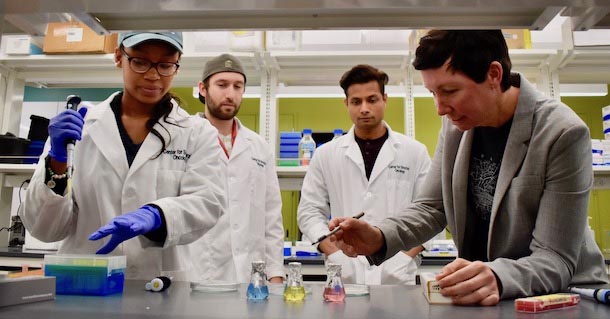
Deborah Kelly, far right, reviews lab results with students (left to right) Madison Evans, Michael Casasanta and G M Jonaid. Photo taken September 2019. IMAGE: JAMIE OBERDICK
Penn State cancer research center joins pandemic fight
4/24/2020
By Jamie Oberdick
UNIVERSITY PARK, Pa. — The Penn State Center for Structural Oncology (CSO) is shifting some of its focus from fighting cancer to fighting COVID-19, with three projects.
The CSO’s director, Deborah Kelly, Lloyd & Dottie Foehr Huck Chair in Molecular Biophysics and professor of biomedical engineering, believes that the same interdisciplinary research approach and collaborative spirit that drives the CSO’s cancer research can be applied to fighting pandemics.
“The broadly collaborative nature of these three COVID-19 projects ties together multiple entities at Penn State, including the College of Engineering, Huck Institutes of the Life Sciences and the College of Medicine,” Kelly said. “The efforts of each will be woven together to ensure the success of all of these new initiatives.”
Jump-starting COVID-19 ravaged lungs with newly modified therapeutics
Kelly and fellow CSO member James Adair, Penn State professor of materials science and engineering, biomedical engineering and pharmacology, are partnering with researchers from the College of Medicine to re-engineer a cancer drug for COVID-19 patients. The team is researching potential viral applications of a protein therapeutic known to be effective at decreasing lung inflammation in cancer patients.
Lung inflammation is caused by a cytokine storm, a severe immune reaction where the immune system releases too many cytokines into the blood too quickly. Cytokines are messenger proteins, requesting more or less immune activity depending on the situation. This can lead to damage to the lungs and other organs as the immune system attacks the organs.
“The therapeutic will be modified for enhanced solubility and use in a nebulizer,” Kelly said. “This way it can go directly to the lungs, rather than be administered intravenously, which is the case for its cancer drug version.”
The project leader is Dr. Scott Halstead, associate professor of pediatrics in the division of critical care medicine at Penn State Health. Other researchers contributing to the project are Gail Matters, associate professor of biochemistry and molecular biology at the Penn State Cancer Institute, along with Kelly and Adair.
The research is one of the projects funded by the Huck Institutes of the Life Sciences coronavirus seed grant initiative.
‘Catch and Kill’ SARS-CoV2, the virus that causes COVID-19
This project utilizes a new DNA-based nanoparticle design, known as synthetic antibodies. Adair is developing nanoparticles that could stick to the protein spikes on the surface of the virus. When these nanoparticles attach to the virus, this can trap the virus in the patient’s upper respiratory system and prevent the virus from entering the cell and infecting the patient. In addition, antivirals placed inside the nanoparticle can neutralize the virus.
“It's both a trap and a trojan horse and that’s what makes it kind of unique,” Kelly said. “This is James Adair’s creation, and my role is working on the modeling of it.”
As the same nanoparticles can be engineered to fluoresce, they could also be used to identify virus particles on surfaces, such as in warehouses, medical facilities or in the home. Kelly said that there are proposals pending to fund this research.
Expanding antibody testing with biotech partners
Kelly is also working on a testing project for an at-home finger-prick test to detect antibodies in the blood. The particular types of antibodies the test would detect, immunoglobulin M (IgM) and immunoglobulin G (IgG), are types of antibodies that the body produces in reaction to a particular protein produced by COVID-19.
“The goal is to partner with a biotech company that has developed an at-home finger-prick antibody diagnostic test,” Kelly said. “The presence of antibodies in the blood indicate exposure and probably immunity against SARS-CoV2. This test may also identify individuals who unwittingly carry the virus and pose a threat through community spread. Although ambitious, we are interested in conducting field tests, the results of which can help provide widespread knowledge of immunity and safety measures as employees return to work.”
Kelly said that manufacturing of such a simple test could potentially be scalable enough for sufficient population testing. The project is currently sponsored by the CSO, and the center is also seeking enterprise partnerships.
“Scalability could be easy with enough industry partners,” Kelly said. “We can order up to 50,000 tests or more as needed once quality control measures prove successful.”



